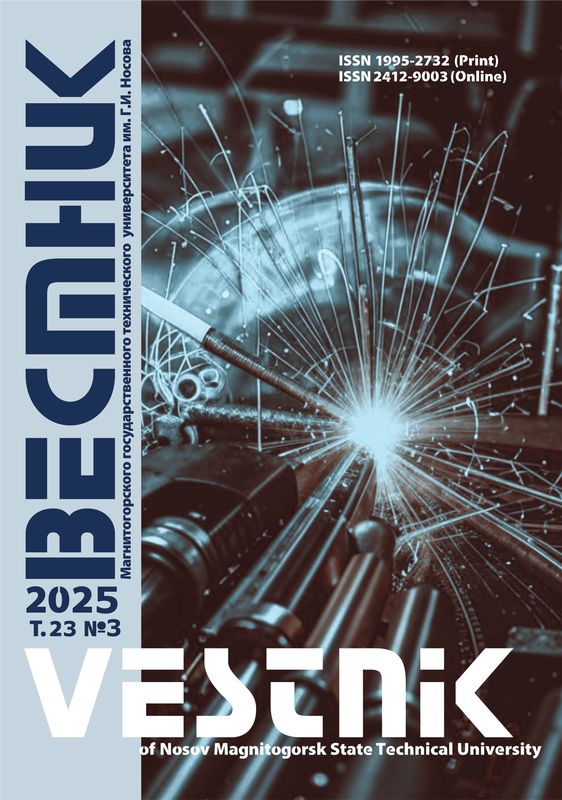DOI: 10.18503/1995-2732-2023-21-4-44-55
Abstract
Problem Statement (Relevance). Thread milling is a flexible and versatile method of thread machining, which has a number of advantages, increasing reliability and the possibility of automating the threading process. The transition to CNC machines entailed an increase in a share of thread milling. To improve accuracy and quality of threading, it is necessary to predict cutting force to assign reasonable values of the parameters of the tool and the thread milling process. The existing studies on thread milling do not contribute to solving this problem with high accuracy in a short time due to the simplified representation of the tool and a large number of clarifying experiments, and the development of tool and machined materials requires an increase in the volume of such work, which requires the development of a theoretical model for calculating cutting force during thread milling. Objectives. To develop a theoretical model for calculating the components of cutting force, when threading with a single-disc milling cutter, to quickly calculate cutting force and conduct only an experiment confirming the calculated values. Methods Applied. Theoretical studies were carried out using the basic provisions of the theory of cutting materials and analytical geometry. Geometric models were performed and tested using Kompas-3D software. Calculations were carried out in PTC Mathcad Prime 3.1. Originality. A theoretical model of cutting force proposed in the paper factors into the complex trajectory of the thread milling process, the geometric parameters of the cutting part, the section of the cut layer, the mechanical properties of tool and machined materials, tool wear and the corner radius of the cutting edge, and the direction of milling. Result. Operability of the developed theoretical model of force during thread milling was confirmed by experimental data, the discrepancy with which did not exceed 15%. Practical Relevance. The proposed theoretical model of force during thread milling is used to proceed to the study on multiple-thread cutters and solve such problems as the analysis of the taper of the thread, the study on the uniformity of thread milling and control of the amplitude of the force components during thread milling.
Keywords
thread milling, thread mill, cutting force, modeling, cut layer
For citation
Malkov O.V., Karelskiy A.S. Theoretical Calculation of the Components of Thread Milling Cutting Forces. Vestnik Magnitogorskogo Gosudarstvennogo Tekhnicheskogo Universiteta im. G.I. Nosova [Vestnik of Nosov Magnitogorsk State Technical University]. 2023, vol. 21, no. 4, pp. 44-55. https://doi.org/10.18503/1995-2732-2023-21-4-44-55
1. Zorokhovich A.A. Rezbofrezerovanie i rezbofrezernye stanki [Threading and threading machines]. Moscow: Oborongiz, 1940, 147 p. (In Russ.)
2. Saikin S.A., Tsvetkov E.V., Tolkachev A.V. Measure-ment of cutting force and torque during thread milling. Naukoemkie tekhnologii v mashinostroenii [Science Intensive Technologies in Mechanical Engineering]. 2023;(1(139)):24-30. (In Russ.) DOI: 10.30987/2223-4608-2023-1-24-30
3. Kosarev V.A., Grechishnikov V.A., Kosarev D.V. Study on force parameters during milling of internal threads with planetary movement of the tool. STIN [Machines and Tools]. 2009;(8):19-22. (In Russ.)
4. Araujo A.C., Silveira J.L., Jun M.B., Kapoor S.G., DeVor R. A model for thread milling cutting forces. International Journal of Machine Tools and Manufacture. 2006;46(15):2057-2065.
5. Malkov O.V., Golovko I.M. Experimental determina-tion of the force model during thread milling. Innovatsii v mashinostroenii: sbornik trudov Mezhdunarodnoy molodezhnoy konferentsii [Innovations in Mechanical Engineering: Proceedings of the International Youth Conference]. Tomsk: Publishing House of Tomsk Polytechnic University, 2012, pp. 73-77. (In Russ.)
6. Araujo A.C., Fromentin G., Poulachon G. Analytical and experimental investigations on thread milling forces in titanium alloy. International Journal of Machine Tools & Manufacture. 2013;67:28-34.
7. Volkov D.I., Saikin S.A. Calculation of cutting force, when milling internal threads in heat-resistant alloys. Vestnik Rybinskoy gosudarstvennoy aviatsionnoy tekhnologicheskoy akademii im. P.A. Solovyeva [Vestnik of Solovyev Rybinsk State Aviation Techno-logical Academy]. 2010;(1(16)):145-150. (In Russ.)
8. Bobrov V.F. Mnogoprokhodnoe narezanie krepezh-nykh rezb reztsom [Multipass cutting of fastening threads with a cutter. Moscow: Mashinostroenie, 1982, 104 p. (In Russ.)
9. Rozenberg Yu.A., Takhman S.I. Sily rezaniya i metody ikh opredeleniya: ucheb. posobie. Chast 1. Obshchie polozheniya [Cutting forces and methods of their determination: study guide. Part 1. General provisions]. Kurgan: Publishing House of Kurgan Mechanical Engineering University, 1995, 130 p. (In Russ.)
10. Rykunov A.N. Tribotechnological features of finishing edge cutting machining and their influence on cut-ting force. Fizika, khimiya i mekhanika tribosistem [Physics, Chemistry and Mechanics of Tribosystems]. 2011;(11):123-131. (In Russ.)
11. Malkov O.V., Golovko I.M., Karelskiy A.S. Theoretical calculation of the parameters of the section of the cut layer during threading. Izvestiya vuzov. Mashi-nostroenie [Proceedings of Higher Educational Insti-tutions. Machine Building]. 2018;(10(703)):24-36. (In Russ.) DOI: 10.18698/0536-1044-2018-10-24-36
12. Malkov O.V., Karelskiy A.S. Cutting force analysis during thread milling. Proceedings of the 7th Interna-tional Conference on Industrial Engineering (ICIE 2021). ICIE 2021. Lecture Notes in Mechanical Engi-neering. Cham, Springer, 2022, pp. 563-573. https://doi.org/10.1007/978-3-030-85230-6_67












